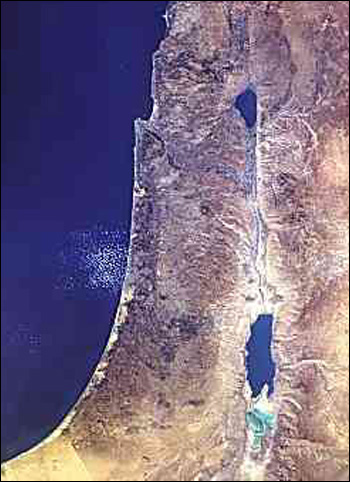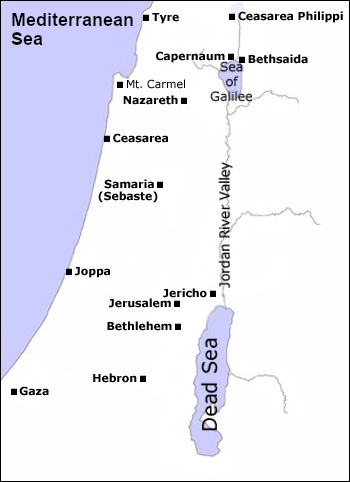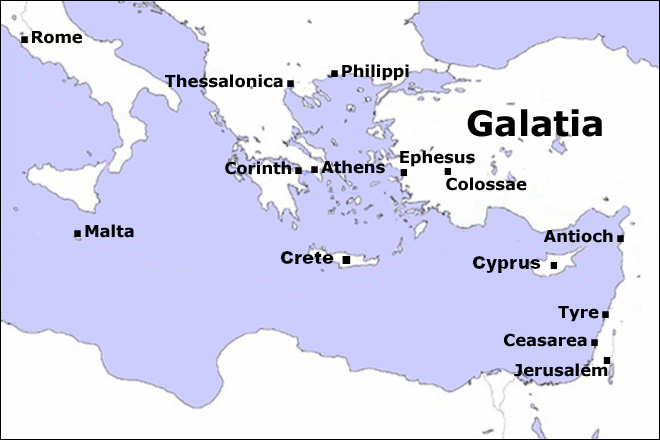New Testament Worlds
The Geography of the New Testament World

Physical Features
The two main differences between what we can see today from a satellite hovering over the east end of the Mediterranean Sea and what would have been seen two thousand years ago are first, that Lake Huleh north of the sea of Galilee is nearly gone. Also called the waters of Merom, Lake Huleh has been steadily silting up for millennia. By modern times, it was mostly a swamp, and from 1950 to 1958 over 12,000 acres of it were drained to become farmland. The second thing we would notice is that the Dead Sea has shrunk. It is literally drying up and is much smaller than it was in New Testament times.

Roman Palestine
In 63-64 B.C., Judea (previously called Judah), along with Samaria and Galilee, came under Roman rule when Pompey intervened in a Jewish dynastic dispute. He was welcomed into Jerusalem by Hyrcanus II, a descendant of the Maccabean family which drove the Seleucid Empire's armies out of Israel generations before and had been allies with the Romans rather than their subjects (I Maccabees 1-8). After several generations of occupation, The Jewish people revolted against the Romans, and in retaliation, the Romans destroyed the Temple in 70 A.D.
Note the village of Nazareth where Jesus grew up.
Note the city of Samaria (sometimes the region is called Samaria and the city is called Sebaste).
Note the cities of Capernaum and Bethsaida on the Sea of Galilee. The region around the sea is also called Galilee.
Take the Roman Palestine map quiz.
Paul's Journeys

The Apostle Paul is known for his missionary journeys. This map lists the major cities he visited; although, it does not try to list all the cites mentioned in the accounts of Paul's journeys in the book of Acts.
Note the cities which received letters from Paul which ended up in our New Testament. (Galatians was written to Christians in the region of Galatia.)
- Rome
- Corinth
- Ephesus
- Philippi
- Colossae
- Thessalonica
Take the Paul's Journeys map quiz.
The Cultures of the New Testament World
Unlike the events chronicled in the Old Testament, the events in the New Testament took place in a relatively short time and space. Nearly all the events in the gospels took place in just three years and even Paul's extensive journeys occupied less than a quarter of the Mediterranean world. We also know more about First-Century Palestine (the name of the Roman Province covering the territory occupied by modern Israel, Palestine, and parts of Jordan and Syria), than you might expect given the intervening twenty centuries. The Romans kept lots of records about their actions and about the cultures they added to their empire. Consequently, when it comes to our understanding of the cultures and customs of the New Testament world, we have a lot of material to sift through and to help us interpret the text.
Jesus and his followers would have spoken Aramaic and only heard Hebrew in the readings at the synagogue and in the Temple. The Roman soldiers would have spoken Latin and the traders and travelers would have often transacted business in Greek. Alongside these language differences, there would have been the related divergences in customs, clothing, and culture. Occasionally the text itself points out the difficulties related to different cultures in such close proximity.
For instance, the Ethiopian eunuch reading Isaiah in Hebrew needed an interpreter (Acts 8:26-39). The Italian centurion Cornelius cannot be visited and converted by the ritually observant Simon Peter until after Peter's vision of the lowered sheet with unclean animals (Acts 10). Occasionally, however, even though the cultural differences are great, the writer just assumes the reader will understand the difficulties as in the story of the "good Samaritan" and Jesus' unique choice and implication in making his "hero" the ultimate outsider (Luke 10:25-37).
Good study Bibles exist to provide this information about the context of a passage in the introductory articles at the beginning of the chapter or book and in margin notes and footnotes. Please use them as you pursue your own New Testament study.